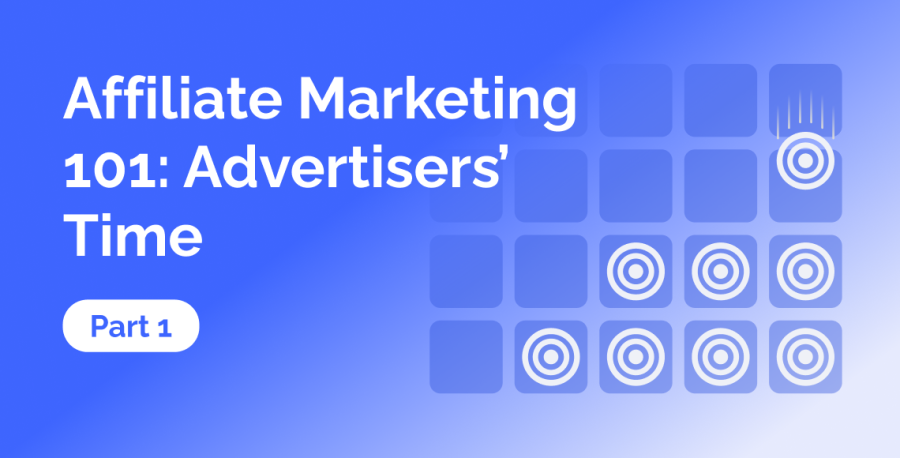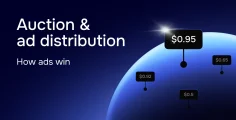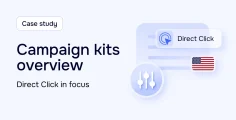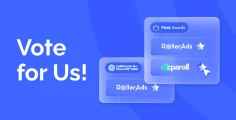Affiliate marketing is promoting other people’s products for a small commission for each sale. Typically, this line of business involves 3 parties:
- Advertiser, who wants to sell a product (or service) en masse but has no time or resources for scaling up, so this person outsources the task
- Publisher, who owns a media channel with a wide reach and wants to profit on this channel by placing advertisements
- Affiliate marketer, who acts as a middleman and arranges a marketing campaign, showing the product ads on the media channel to some users
The affiliate is held responsible for the campaign success by putting the money on where the mouth is. When the affiliates start to work together, they become a media buying team. The ultimate goal of the whole enterprise is to bring in the target users, a.k.a. drive the traffic, to the advertiser, via the media channels provided by the publishers. The money flows the following way: user → advertiser → affiliate → publisher, where each subsequent payee earns a commission.
Let’s agree henceforth to use the terms affiliate marketer and advertiser interchangeably, because the affiliate does the job of advertising. In order to succeed, each party needs to develop a strategy on how to enter the market. Due to the space constraints, we decided to split the article. This is the first part, which focuses on the advertiser’s side of the matter. The second part will tell the publishers how to develop the strategy and which factors to consider.
Targeting the Audience and Network
Whether working solo or in a team, the affiliate has to meet the requirements of the advertiser’s offer and design the campaign accordingly, or the payment may be cancelled. The affiliate also has to comply with the terms of the publisher’s platform, or the non-compliant ads may be removed, and the account can get banhammered.
First step is to figure out the target audience. Even mass market is the choice that has to be made deliberately. The target audience is made of the demographics, politics, culture, economics. To help you out, there is a plethora of tools to facilitate your understanding: from social media monitoring to classic surveys. Think about the customer persona that would be interested in your product, and the events that can convert random people into prospects.
Second, having decided on the target audience, you need the right affiliate network to partner with. Why not to work directly instead, you may ask — because of the stack of technologies the network provides.
Nowadays, the ad placements are bought and sold during real-time bidding — a fully automated process, which is technology-intensive. Moreover, tracking solutions can have either in-house origins or be outsourced. This in turn affects the level of transparency, control, and profitability.
Why siding with RollerAds? Here are a few reasons:
- In-depth knowledge of Push, OnClick, and In-Page Push ad formats
- Global reach with more than 2 billion of impressions daily
- Wide range of targeting options
- CPC, CPM, and Smart pricing models
- Unique optimization algorithms
- Strong support team
- Huge variety of payment options
- Built-in creatives library and anti-fraud system
Finessing the Creatives and Models
Speaking of high-quality creatives — you’re going to need some, because 90% of information perceived is visuals. Promo-materials are not limited to pictures only but can include videos, GIFs, music, or sounds. Moreover, the audiovisual component has to be complemented with compelling texting.
Of course, you can do everything yourself, using special software and databases. If you don’t like something in particular, you can outsource it to a professional. Or you can delegate partially to a set of AI, e.g., ChatGPT + Midjourney. Just make sure to oversee the results of the neural networks.
Remember that human short-term memory is very limited, which is strained even further by the global competition and information abundance. So keep your ads succinct: simple, to the point, and meaningful.
For the ads to be served, you have to pay for the ad spots. But payment models can differ substantially: Cost-per-Action, Cost-per-Mille, at RollerAds there are also SmartCPA and SmartCPM — which one to choose? In a nutshell, your Click-Through-Rate is the answer.
In terms of marketing funnel, CPA is one step shorter and assumes some kind of CTR already. CPM, on the other hand, assumes nothing and can help to squeeze out more clicks for the same price. High CTR can be achieved with experience and compelling creatives, mentioned earlier. High CTR is the reason to favor SmartCPM, which is an automated version of CPM.
How to Assess and Remain Amiable
Finally, when it comes to media buying teams and affiliate’s everyday work, it is important to maintain the unity and friendly ambiance. Whether the interactions are vertical (advertiser-affiliate) or horizontal (affiliate-affiliate), good relationships are the key to smooth and productive work.
When it comes to any work, your nemesis is sloth. Focus on yourself and try getting better, instead of giving tips to other people. They don’t like big talkers and favor the industrious peers, plus you will accomplish more this way.
If the necessity to assess the performance of the colleagues arises, start off with their strengths. Only afterward switch to the weaknesses but never call them like that, unless you are fine with people holding a grudge against you. Label the weak spots as the room for an improvement, and suggest the improvements, so people don’t feel as if you simply dislike them.
To be continued…
For the campaign to be successful, the affiliate has to specify the target audience. The next step, is to consider the pros of the network to work with (or going solo). Then, it is crucial to do the homework, get to know local specifics, and design the creatives. Don’t forget about the payout model — as a rule of a thumb, CPC is more forgiving at the beginning.
And keep good relationships with as many partners as possible. Who knows, they might help you out one day.





